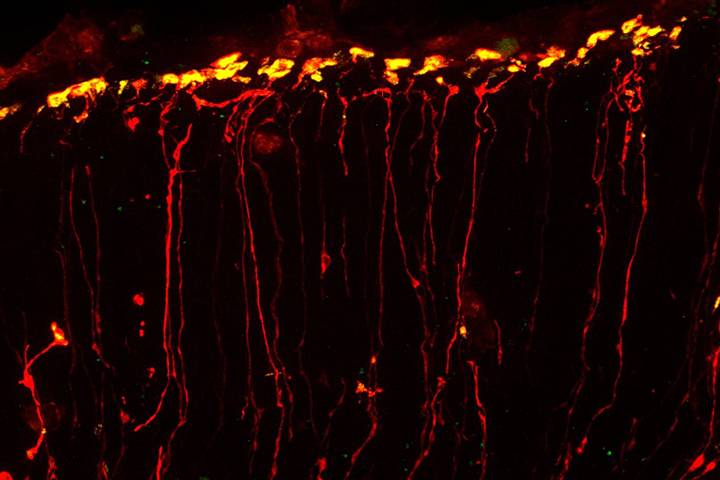
Duke University scientists have caught the first glimpse of molecules shuttling along a sort of highway running the length of neural stem cells, which are crucial to the development of new neurons.
This new view has given them an intriguing clue that a protein deficient in Fragile X syndrome, an autism-related disorder that causes intellectual disability, is responsible for moving at least some of this molecular cargo up and down the stem cells. The findings appear online Dec. 1 in Current Biology.
“The moving molecules we saw in these stem cells could be crucial for their function -- including their decision to become neurons,” said the study’s senior investigator Debra Silver, an assistant professor of molecular genetics and microbiology at the Duke University School of Medicine. “We’re excited about these new discoveries and have many more questions.”
Neural stem cells are buried deep within the brain and project long, thin extensions outward. The ends of these cells, called “endfeet,” go so far as to reach the uppermost layer of the brain and prevent neurons, which climb up these thin strands, from migrating further.
Compared to the cell’s main body, these far-flung endfeet are living in a vastly different environment of the brain. Their surroundings may influence whether a neural stem cell generates another stem cell or becomes a neuron. That determination affects how many neurons the brain can generate.
These cells are so long that researchers thought that, like neurons, they would need to ship some of their contents long distances, including the messenger RNA molecule that is needed to manufacture proteins.
After toiling with the microscope, postdoctoral researcher Louis-Jan Pilaz was, for the first time, able to see mRNAs moving down the neural stem cell’s shaft, frame-by-frame.
“The [fluorescently tagged mRNAs] were stopping sometimes, and then they would keep going, like they have an intention,” Pilaz said. “No one had seen molecules moving at this speed within neural stem cells before.”
The results suggest that neural stem cells are highways for molecular transport, carrying not just mRNAs but also many other types of proteins, Silver said.
When mRNA reaches the endfeet it gets translated into protein by other cellular machinery. Silver’s group was able to show this definitively with a new test they developed that allowed them to isolate the endfeet from the rest of the cell. Using fluorescent tagging, graduate student Ashley Lennox was able to visualize new proteins being made within the endfeet.
“[Until now], there have been really limited tools for being able to evaluate this in an intact tissue, and that’s where our study provides a new model,” Silver said.
Silver’s team knew that mRNA was shipped in a controlled fashion to the endfeet, rather than merely diffusing, but they didn’t know which other molecules might control these steps. They examined a handful of molecules known to influence RNA dynamics and were surpised to find that the Fragile X syndrome protein called FMRP bound and carried the mRNAs.
Previous studies from several groups have implicated FMRP in neural stem cell function, but very little was understood about its role in brain development.
The group found 115 different mRNAs that FMRP latched onto: about 30 percent of these are linked to brain diseases, and about half of those are enriched in autism. They picked one of these mRNAs and showed, using a mouse model of Fragile X, that mRNA needed FMRP to arrive at the neural stem cell’s endfeet.
“This was really exciting. We clearly saw enrichment of a subset of RNAs, that we were able to go on and validate using other methods,” Silver said.
The group is conducting further studies to understand how production of protein is controlled within the endfeet, and whether it changes over the course of development. The scientists are also working to parse FMRP’s different functions to gauge their effects on brain development.
The research was supported by Fay/Frank Seed grant from the Brain Research Foundation.
CITATION: "Dynamic mRNA Transport and Local Translation in Radial Glial Progenitors of the Developing Brain," Louis-Jan Pilaz, Ashley L. Lennox, Jeremy P. Rouanet, Debra L. Silver. Current Biology, December 19, 2016. DOI: 10.1016/j.cub.2016.10.040